1803ICT/7610ICT: Analyzing & Enhancing Amazon Australia's HAS with IS
VerifiedAdded on 2023/06/10
|22
|5365
|76
Report
AI Summary
This report provides an in-depth analysis of Amazon Australia's business operations through the lens of Human Activity Systems (HAS). It begins with an overview of Amazon Australia, including its strategy, competitive positioning, and operations, utilizing Mintzberg's classification and Porter's Value Chain Model. The report identifies a problematic HAS related to inaccurate stock levels and analyzes the roles of stakeholders involved. It then proposes a new information system to address these issues, detailing its data requirements, process model, and impact on stakeholders. The report concludes with recommendations for Amazon Australia's management on leveraging the new information system to enhance customer service and ensure its success.
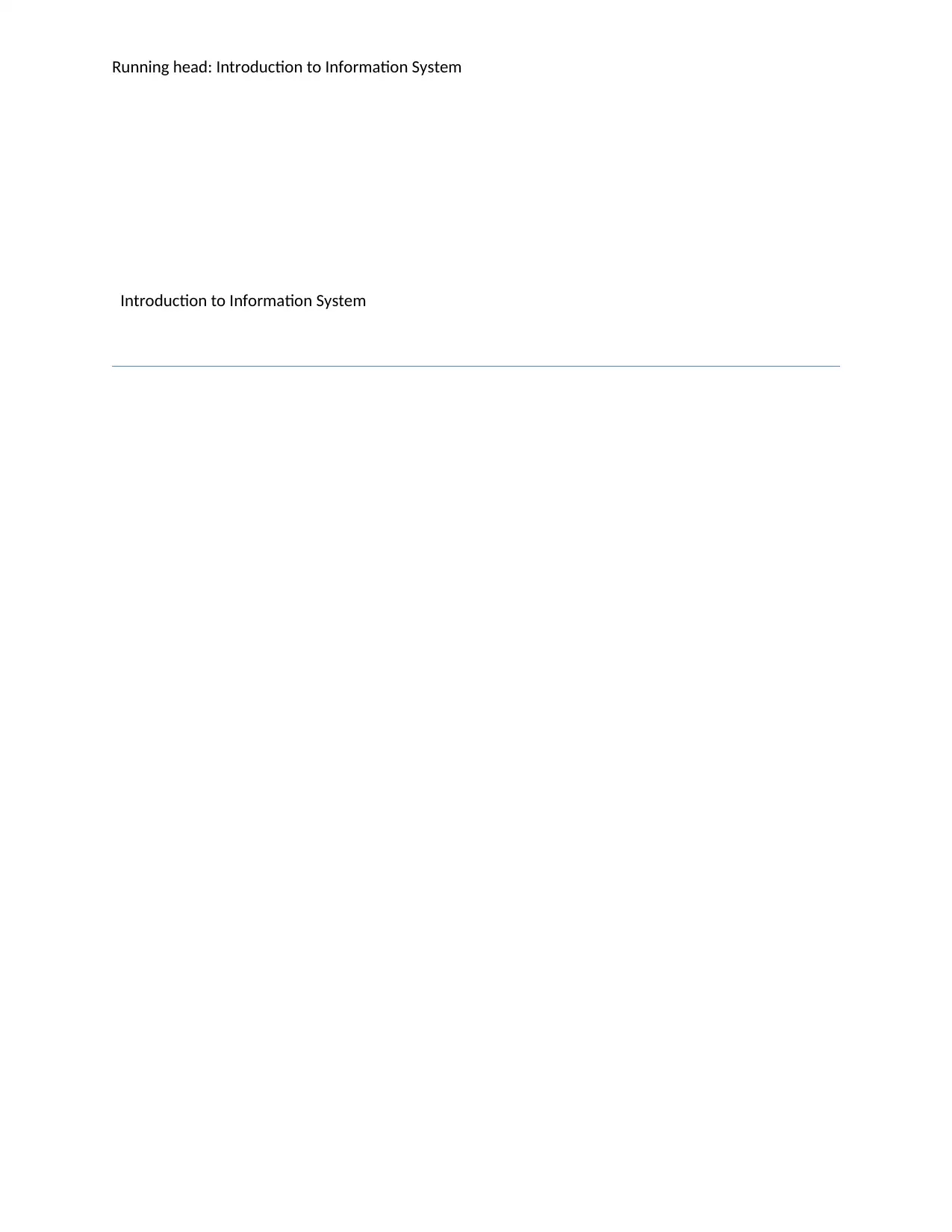
Running head: Introduction to Information System
Introduction to Information System
Introduction to Information System
Paraphrase This Document
Need a fresh take? Get an instant paraphrase of this document with our AI Paraphraser
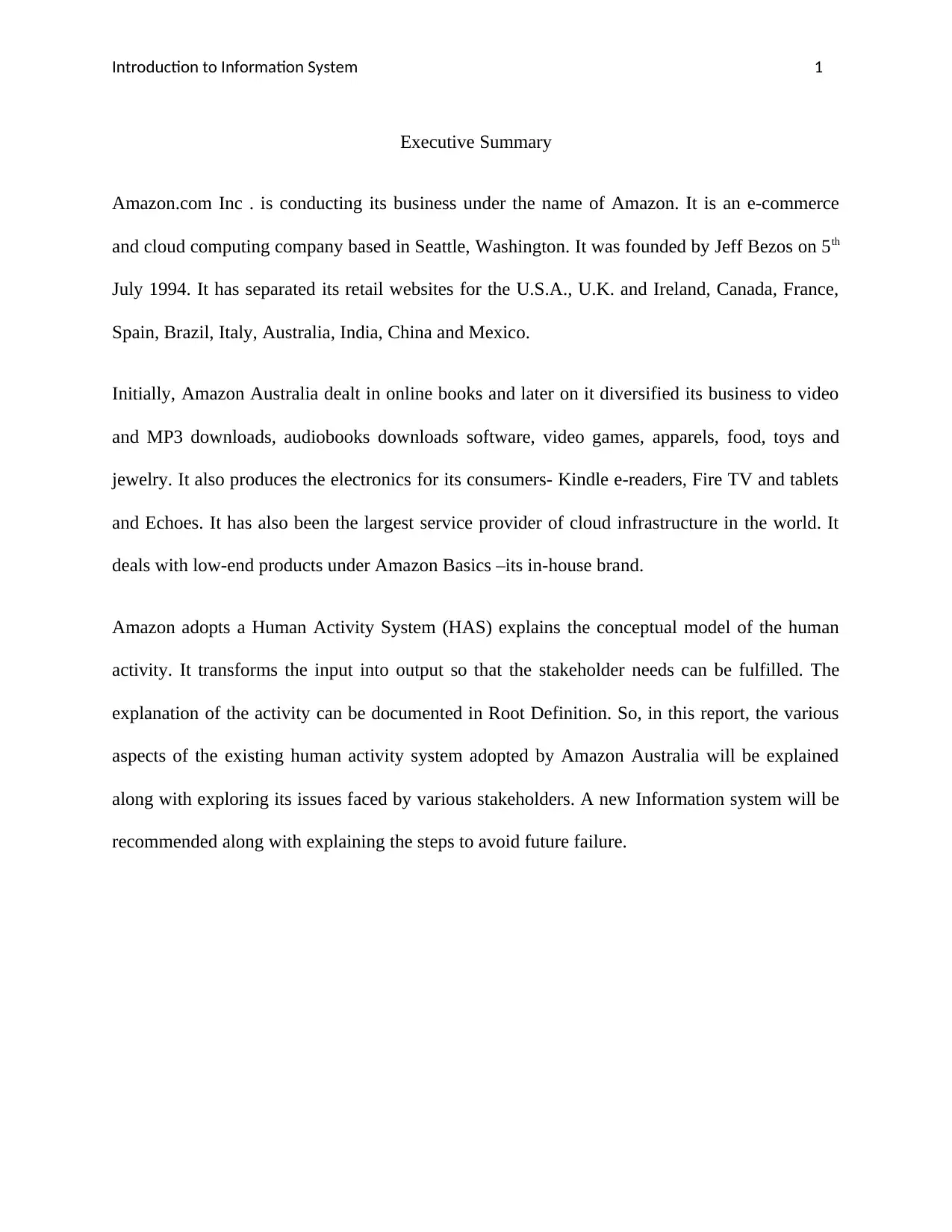
Introduction to Information System 1
Executive Summary
Amazon.com Inc . is conducting its business under the name of Amazon. It is an e-commerce
and cloud computing company based in Seattle, Washington. It was founded by Jeff Bezos on 5th
July 1994. It has separated its retail websites for the U.S.A., U.K. and Ireland, Canada, France,
Spain, Brazil, Italy, Australia, India, China and Mexico.
Initially, Amazon Australia dealt in online books and later on it diversified its business to video
and MP3 downloads, audiobooks downloads software, video games, apparels, food, toys and
jewelry. It also produces the electronics for its consumers- Kindle e-readers, Fire TV and tablets
and Echoes. It has also been the largest service provider of cloud infrastructure in the world. It
deals with low-end products under Amazon Basics –its in-house brand.
Amazon adopts a Human Activity System (HAS) explains the conceptual model of the human
activity. It transforms the input into output so that the stakeholder needs can be fulfilled. The
explanation of the activity can be documented in Root Definition. So, in this report, the various
aspects of the existing human activity system adopted by Amazon Australia will be explained
along with exploring its issues faced by various stakeholders. A new Information system will be
recommended along with explaining the steps to avoid future failure.
Executive Summary
Amazon.com Inc . is conducting its business under the name of Amazon. It is an e-commerce
and cloud computing company based in Seattle, Washington. It was founded by Jeff Bezos on 5th
July 1994. It has separated its retail websites for the U.S.A., U.K. and Ireland, Canada, France,
Spain, Brazil, Italy, Australia, India, China and Mexico.
Initially, Amazon Australia dealt in online books and later on it diversified its business to video
and MP3 downloads, audiobooks downloads software, video games, apparels, food, toys and
jewelry. It also produces the electronics for its consumers- Kindle e-readers, Fire TV and tablets
and Echoes. It has also been the largest service provider of cloud infrastructure in the world. It
deals with low-end products under Amazon Basics –its in-house brand.
Amazon adopts a Human Activity System (HAS) explains the conceptual model of the human
activity. It transforms the input into output so that the stakeholder needs can be fulfilled. The
explanation of the activity can be documented in Root Definition. So, in this report, the various
aspects of the existing human activity system adopted by Amazon Australia will be explained
along with exploring its issues faced by various stakeholders. A new Information system will be
recommended along with explaining the steps to avoid future failure.
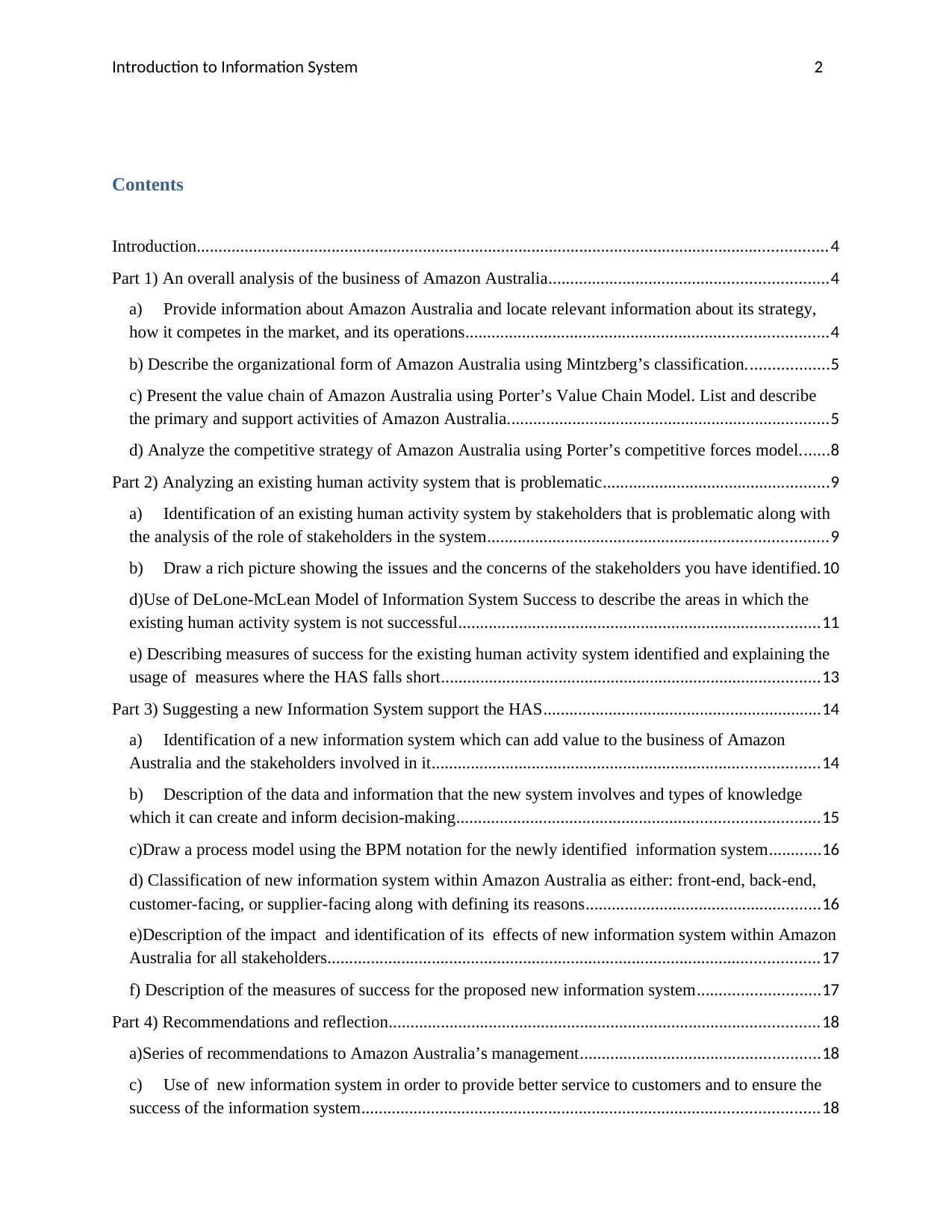
Introduction to Information System 2
Contents
Introduction.................................................................................................................................................4
Part 1) An overall analysis of the business of Amazon Australia................................................................4
a) Provide information about Amazon Australia and locate relevant information about its strategy,
how it competes in the market, and its operations...................................................................................4
b) Describe the organizational form of Amazon Australia using Mintzberg’s classification...................5
c) Present the value chain of Amazon Australia using Porter’s Value Chain Model. List and describe
the primary and support activities of Amazon Australia..........................................................................5
d) Analyze the competitive strategy of Amazon Australia using Porter’s competitive forces model.......8
Part 2) Analyzing an existing human activity system that is problematic....................................................9
a) Identification of an existing human activity system by stakeholders that is problematic along with
the analysis of the role of stakeholders in the system..............................................................................9
b) Draw a rich picture showing the issues and the concerns of the stakeholders you have identified.10
d)Use of DeLone-McLean Model of Information System Success to describe the areas in which the
existing human activity system is not successful...................................................................................11
e) Describing measures of success for the existing human activity system identified and explaining the
usage of measures where the HAS falls short.......................................................................................13
Part 3) Suggesting a new Information System support the HAS................................................................14
a) Identification of a new information system which can add value to the business of Amazon
Australia and the stakeholders involved in it.........................................................................................14
b) Description of the data and information that the new system involves and types of knowledge
which it can create and inform decision-making...................................................................................15
c)Draw a process model using the BPM notation for the newly identified information system............16
d) Classification of new information system within Amazon Australia as either: front-end, back-end,
customer-facing, or supplier-facing along with defining its reasons......................................................16
e)Description of the impact and identification of its effects of new information system within Amazon
Australia for all stakeholders.................................................................................................................17
f) Description of the measures of success for the proposed new information system............................17
Part 4) Recommendations and reflection...................................................................................................18
a)Series of recommendations to Amazon Australia’s management.......................................................18
c) Use of new information system in order to provide better service to customers and to ensure the
success of the information system.........................................................................................................18
Contents
Introduction.................................................................................................................................................4
Part 1) An overall analysis of the business of Amazon Australia................................................................4
a) Provide information about Amazon Australia and locate relevant information about its strategy,
how it competes in the market, and its operations...................................................................................4
b) Describe the organizational form of Amazon Australia using Mintzberg’s classification...................5
c) Present the value chain of Amazon Australia using Porter’s Value Chain Model. List and describe
the primary and support activities of Amazon Australia..........................................................................5
d) Analyze the competitive strategy of Amazon Australia using Porter’s competitive forces model.......8
Part 2) Analyzing an existing human activity system that is problematic....................................................9
a) Identification of an existing human activity system by stakeholders that is problematic along with
the analysis of the role of stakeholders in the system..............................................................................9
b) Draw a rich picture showing the issues and the concerns of the stakeholders you have identified.10
d)Use of DeLone-McLean Model of Information System Success to describe the areas in which the
existing human activity system is not successful...................................................................................11
e) Describing measures of success for the existing human activity system identified and explaining the
usage of measures where the HAS falls short.......................................................................................13
Part 3) Suggesting a new Information System support the HAS................................................................14
a) Identification of a new information system which can add value to the business of Amazon
Australia and the stakeholders involved in it.........................................................................................14
b) Description of the data and information that the new system involves and types of knowledge
which it can create and inform decision-making...................................................................................15
c)Draw a process model using the BPM notation for the newly identified information system............16
d) Classification of new information system within Amazon Australia as either: front-end, back-end,
customer-facing, or supplier-facing along with defining its reasons......................................................16
e)Description of the impact and identification of its effects of new information system within Amazon
Australia for all stakeholders.................................................................................................................17
f) Description of the measures of success for the proposed new information system............................17
Part 4) Recommendations and reflection...................................................................................................18
a)Series of recommendations to Amazon Australia’s management.......................................................18
c) Use of new information system in order to provide better service to customers and to ensure the
success of the information system.........................................................................................................18
⊘ This is a preview!⊘
Do you want full access?
Subscribe today to unlock all pages.

Trusted by 1+ million students worldwide

Introduction to Information System 3
Conclusion.................................................................................................................................................18
Referencing...............................................................................................................................................19
Conclusion.................................................................................................................................................18
Referencing...............................................................................................................................................19
Paraphrase This Document
Need a fresh take? Get an instant paraphrase of this document with our AI Paraphraser
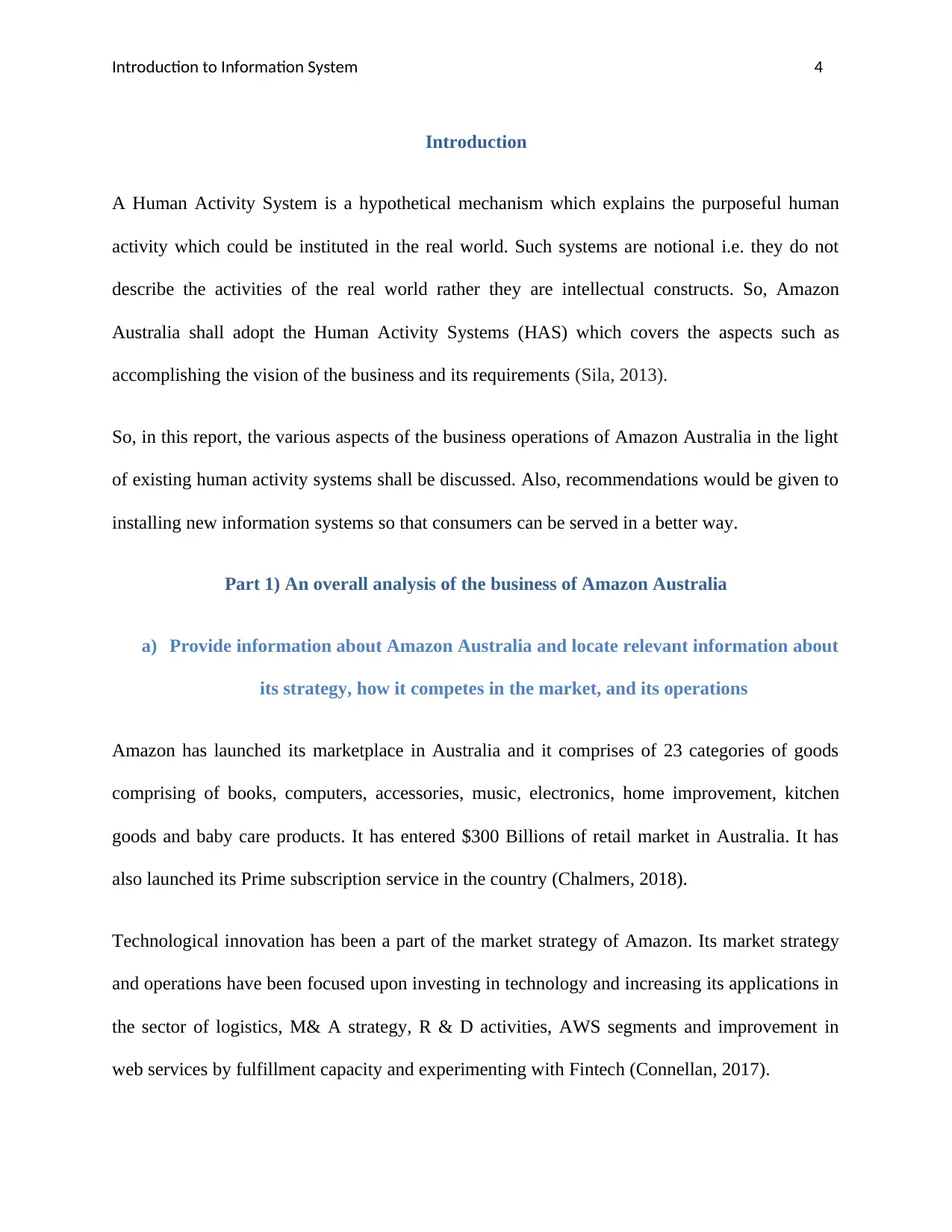
Introduction to Information System 4
Introduction
A Human Activity System is a hypothetical mechanism which explains the purposeful human
activity which could be instituted in the real world. Such systems are notional i.e. they do not
describe the activities of the real world rather they are intellectual constructs. So, Amazon
Australia shall adopt the Human Activity Systems (HAS) which covers the aspects such as
accomplishing the vision of the business and its requirements (Sila, 2013).
So, in this report, the various aspects of the business operations of Amazon Australia in the light
of existing human activity systems shall be discussed. Also, recommendations would be given to
installing new information systems so that consumers can be served in a better way.
Part 1) An overall analysis of the business of Amazon Australia
a) Provide information about Amazon Australia and locate relevant information about
its strategy, how it competes in the market, and its operations
Amazon has launched its marketplace in Australia and it comprises of 23 categories of goods
comprising of books, computers, accessories, music, electronics, home improvement, kitchen
goods and baby care products. It has entered $300 Billions of retail market in Australia. It has
also launched its Prime subscription service in the country (Chalmers, 2018).
Technological innovation has been a part of the market strategy of Amazon. Its market strategy
and operations have been focused upon investing in technology and increasing its applications in
the sector of logistics, M& A strategy, R & D activities, AWS segments and improvement in
web services by fulfillment capacity and experimenting with Fintech (Connellan, 2017).
Introduction
A Human Activity System is a hypothetical mechanism which explains the purposeful human
activity which could be instituted in the real world. Such systems are notional i.e. they do not
describe the activities of the real world rather they are intellectual constructs. So, Amazon
Australia shall adopt the Human Activity Systems (HAS) which covers the aspects such as
accomplishing the vision of the business and its requirements (Sila, 2013).
So, in this report, the various aspects of the business operations of Amazon Australia in the light
of existing human activity systems shall be discussed. Also, recommendations would be given to
installing new information systems so that consumers can be served in a better way.
Part 1) An overall analysis of the business of Amazon Australia
a) Provide information about Amazon Australia and locate relevant information about
its strategy, how it competes in the market, and its operations
Amazon has launched its marketplace in Australia and it comprises of 23 categories of goods
comprising of books, computers, accessories, music, electronics, home improvement, kitchen
goods and baby care products. It has entered $300 Billions of retail market in Australia. It has
also launched its Prime subscription service in the country (Chalmers, 2018).
Technological innovation has been a part of the market strategy of Amazon. Its market strategy
and operations have been focused upon investing in technology and increasing its applications in
the sector of logistics, M& A strategy, R & D activities, AWS segments and improvement in
web services by fulfillment capacity and experimenting with Fintech (Connellan, 2017).
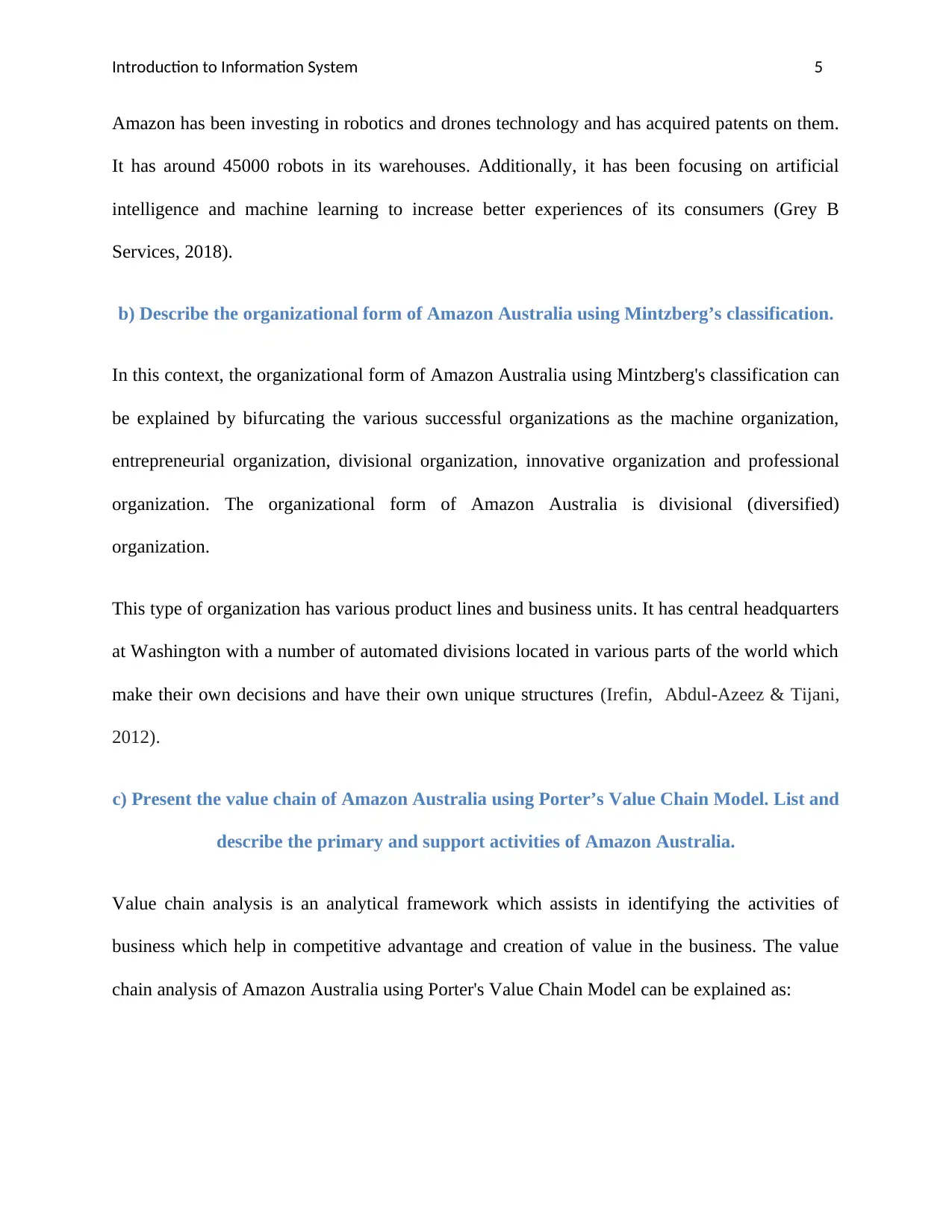
Introduction to Information System 5
Amazon has been investing in robotics and drones technology and has acquired patents on them.
It has around 45000 robots in its warehouses. Additionally, it has been focusing on artificial
intelligence and machine learning to increase better experiences of its consumers (Grey B
Services, 2018).
b) Describe the organizational form of Amazon Australia using Mintzberg’s classification.
In this context, the organizational form of Amazon Australia using Mintzberg's classification can
be explained by bifurcating the various successful organizations as the machine organization,
entrepreneurial organization, divisional organization, innovative organization and professional
organization. The organizational form of Amazon Australia is divisional (diversified)
organization.
This type of organization has various product lines and business units. It has central headquarters
at Washington with a number of automated divisions located in various parts of the world which
make their own decisions and have their own unique structures (Irefin, Abdul-Azeez & Tijani,
2012).
c) Present the value chain of Amazon Australia using Porter’s Value Chain Model. List and
describe the primary and support activities of Amazon Australia.
Value chain analysis is an analytical framework which assists in identifying the activities of
business which help in competitive advantage and creation of value in the business. The value
chain analysis of Amazon Australia using Porter's Value Chain Model can be explained as:
Amazon has been investing in robotics and drones technology and has acquired patents on them.
It has around 45000 robots in its warehouses. Additionally, it has been focusing on artificial
intelligence and machine learning to increase better experiences of its consumers (Grey B
Services, 2018).
b) Describe the organizational form of Amazon Australia using Mintzberg’s classification.
In this context, the organizational form of Amazon Australia using Mintzberg's classification can
be explained by bifurcating the various successful organizations as the machine organization,
entrepreneurial organization, divisional organization, innovative organization and professional
organization. The organizational form of Amazon Australia is divisional (diversified)
organization.
This type of organization has various product lines and business units. It has central headquarters
at Washington with a number of automated divisions located in various parts of the world which
make their own decisions and have their own unique structures (Irefin, Abdul-Azeez & Tijani,
2012).
c) Present the value chain of Amazon Australia using Porter’s Value Chain Model. List and
describe the primary and support activities of Amazon Australia.
Value chain analysis is an analytical framework which assists in identifying the activities of
business which help in competitive advantage and creation of value in the business. The value
chain analysis of Amazon Australia using Porter's Value Chain Model can be explained as:
⊘ This is a preview!⊘
Do you want full access?
Subscribe today to unlock all pages.

Trusted by 1+ million students worldwide
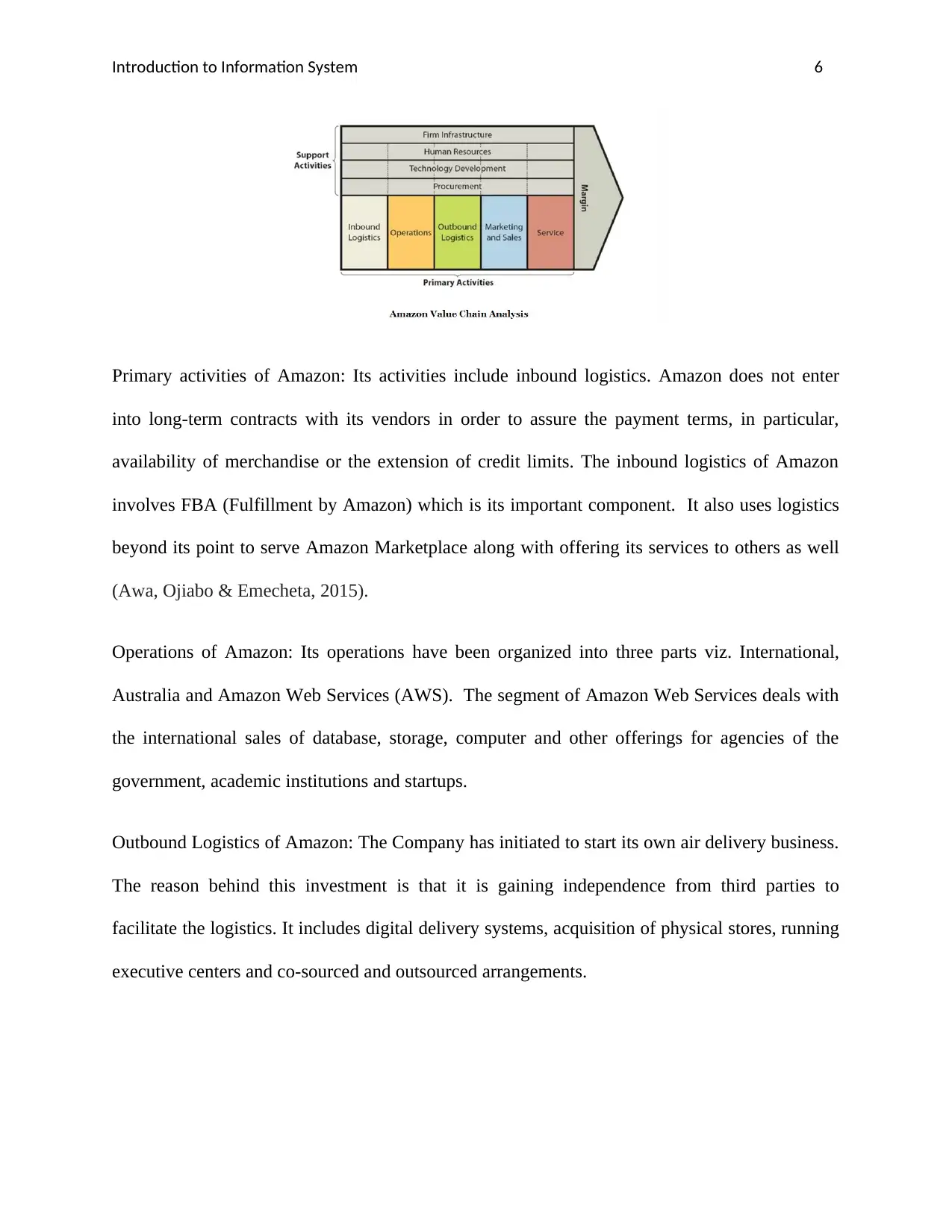
Introduction to Information System 6
Primary activities of Amazon: Its activities include inbound logistics. Amazon does not enter
into long-term contracts with its vendors in order to assure the payment terms, in particular,
availability of merchandise or the extension of credit limits. The inbound logistics of Amazon
involves FBA (Fulfillment by Amazon) which is its important component. It also uses logistics
beyond its point to serve Amazon Marketplace along with offering its services to others as well
(Awa, Ojiabo & Emecheta, 2015).
Operations of Amazon: Its operations have been organized into three parts viz. International,
Australia and Amazon Web Services (AWS). The segment of Amazon Web Services deals with
the international sales of database, storage, computer and other offerings for agencies of the
government, academic institutions and startups.
Outbound Logistics of Amazon: The Company has initiated to start its own air delivery business.
The reason behind this investment is that it is gaining independence from third parties to
facilitate the logistics. It includes digital delivery systems, acquisition of physical stores, running
executive centers and co-sourced and outsourced arrangements.
Primary activities of Amazon: Its activities include inbound logistics. Amazon does not enter
into long-term contracts with its vendors in order to assure the payment terms, in particular,
availability of merchandise or the extension of credit limits. The inbound logistics of Amazon
involves FBA (Fulfillment by Amazon) which is its important component. It also uses logistics
beyond its point to serve Amazon Marketplace along with offering its services to others as well
(Awa, Ojiabo & Emecheta, 2015).
Operations of Amazon: Its operations have been organized into three parts viz. International,
Australia and Amazon Web Services (AWS). The segment of Amazon Web Services deals with
the international sales of database, storage, computer and other offerings for agencies of the
government, academic institutions and startups.
Outbound Logistics of Amazon: The Company has initiated to start its own air delivery business.
The reason behind this investment is that it is gaining independence from third parties to
facilitate the logistics. It includes digital delivery systems, acquisition of physical stores, running
executive centers and co-sourced and outsourced arrangements.
Paraphrase This Document
Need a fresh take? Get an instant paraphrase of this document with our AI Paraphraser
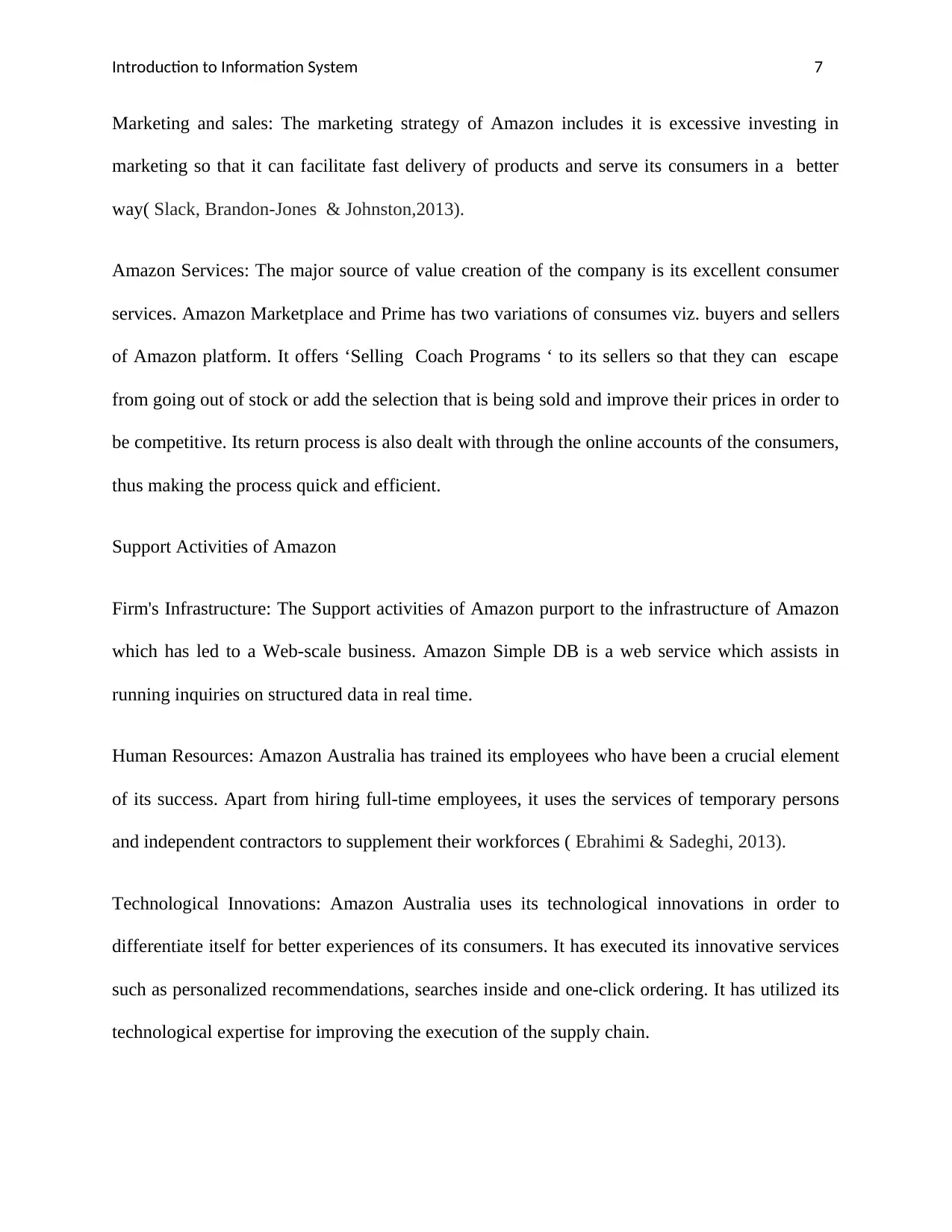
Introduction to Information System 7
Marketing and sales: The marketing strategy of Amazon includes it is excessive investing in
marketing so that it can facilitate fast delivery of products and serve its consumers in a better
way( Slack, Brandon-Jones & Johnston,2013).
Amazon Services: The major source of value creation of the company is its excellent consumer
services. Amazon Marketplace and Prime has two variations of consumes viz. buyers and sellers
of Amazon platform. It offers ‘Selling Coach Programs ‘ to its sellers so that they can escape
from going out of stock or add the selection that is being sold and improve their prices in order to
be competitive. Its return process is also dealt with through the online accounts of the consumers,
thus making the process quick and efficient.
Support Activities of Amazon
Firm's Infrastructure: The Support activities of Amazon purport to the infrastructure of Amazon
which has led to a Web-scale business. Amazon Simple DB is a web service which assists in
running inquiries on structured data in real time.
Human Resources: Amazon Australia has trained its employees who have been a crucial element
of its success. Apart from hiring full-time employees, it uses the services of temporary persons
and independent contractors to supplement their workforces ( Ebrahimi & Sadeghi, 2013).
Technological Innovations: Amazon Australia uses its technological innovations in order to
differentiate itself for better experiences of its consumers. It has executed its innovative services
such as personalized recommendations, searches inside and one-click ordering. It has utilized its
technological expertise for improving the execution of the supply chain.
Marketing and sales: The marketing strategy of Amazon includes it is excessive investing in
marketing so that it can facilitate fast delivery of products and serve its consumers in a better
way( Slack, Brandon-Jones & Johnston,2013).
Amazon Services: The major source of value creation of the company is its excellent consumer
services. Amazon Marketplace and Prime has two variations of consumes viz. buyers and sellers
of Amazon platform. It offers ‘Selling Coach Programs ‘ to its sellers so that they can escape
from going out of stock or add the selection that is being sold and improve their prices in order to
be competitive. Its return process is also dealt with through the online accounts of the consumers,
thus making the process quick and efficient.
Support Activities of Amazon
Firm's Infrastructure: The Support activities of Amazon purport to the infrastructure of Amazon
which has led to a Web-scale business. Amazon Simple DB is a web service which assists in
running inquiries on structured data in real time.
Human Resources: Amazon Australia has trained its employees who have been a crucial element
of its success. Apart from hiring full-time employees, it uses the services of temporary persons
and independent contractors to supplement their workforces ( Ebrahimi & Sadeghi, 2013).
Technological Innovations: Amazon Australia uses its technological innovations in order to
differentiate itself for better experiences of its consumers. It has executed its innovative services
such as personalized recommendations, searches inside and one-click ordering. It has utilized its
technological expertise for improving the execution of the supply chain.
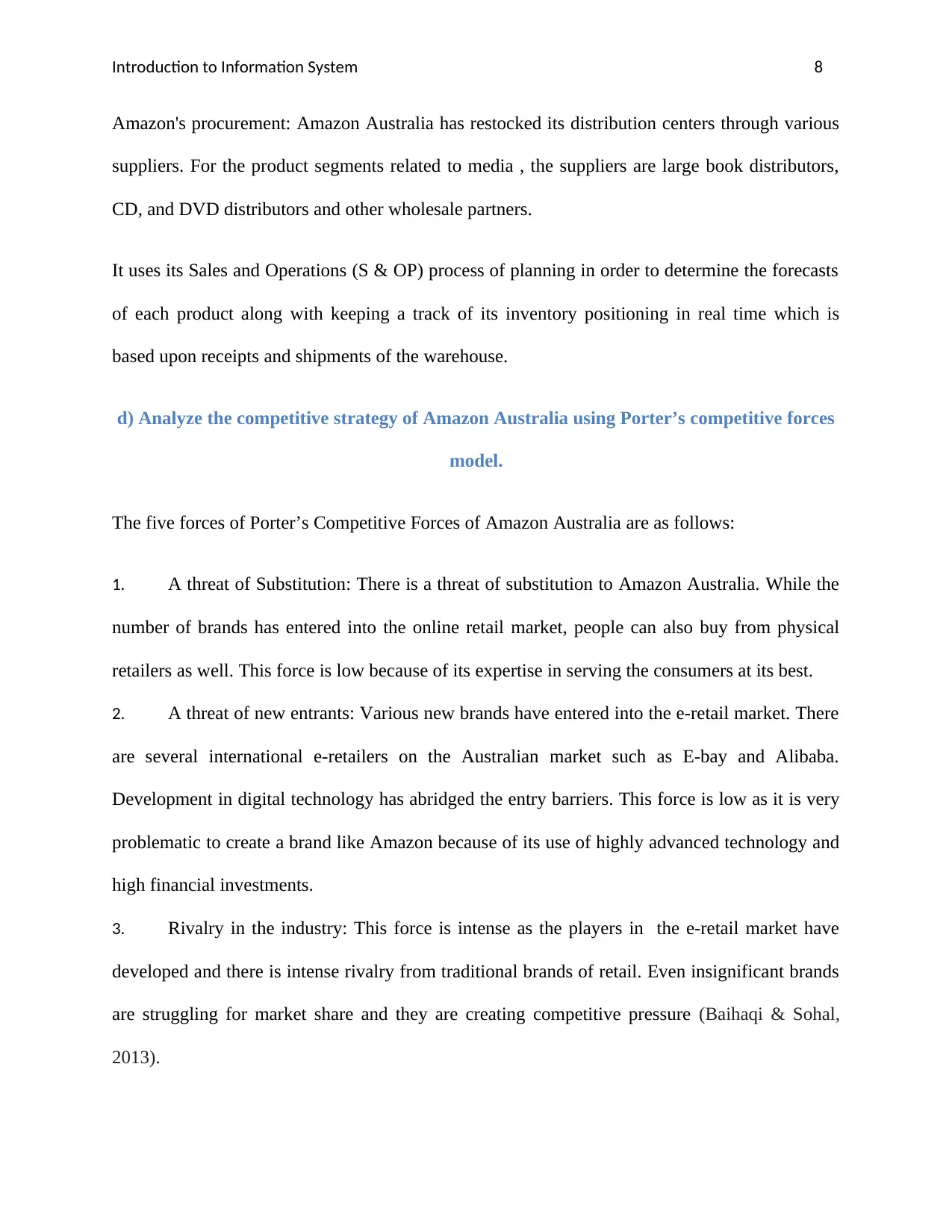
Introduction to Information System 8
Amazon's procurement: Amazon Australia has restocked its distribution centers through various
suppliers. For the product segments related to media , the suppliers are large book distributors,
CD, and DVD distributors and other wholesale partners.
It uses its Sales and Operations (S & OP) process of planning in order to determine the forecasts
of each product along with keeping a track of its inventory positioning in real time which is
based upon receipts and shipments of the warehouse.
d) Analyze the competitive strategy of Amazon Australia using Porter’s competitive forces
model.
The five forces of Porter’s Competitive Forces of Amazon Australia are as follows:
1. A threat of Substitution: There is a threat of substitution to Amazon Australia. While the
number of brands has entered into the online retail market, people can also buy from physical
retailers as well. This force is low because of its expertise in serving the consumers at its best.
2. A threat of new entrants: Various new brands have entered into the e-retail market. There
are several international e-retailers on the Australian market such as E-bay and Alibaba.
Development in digital technology has abridged the entry barriers. This force is low as it is very
problematic to create a brand like Amazon because of its use of highly advanced technology and
high financial investments.
3. Rivalry in the industry: This force is intense as the players in the e-retail market have
developed and there is intense rivalry from traditional brands of retail. Even insignificant brands
are struggling for market share and they are creating competitive pressure (Baihaqi & Sohal,
2013).
Amazon's procurement: Amazon Australia has restocked its distribution centers through various
suppliers. For the product segments related to media , the suppliers are large book distributors,
CD, and DVD distributors and other wholesale partners.
It uses its Sales and Operations (S & OP) process of planning in order to determine the forecasts
of each product along with keeping a track of its inventory positioning in real time which is
based upon receipts and shipments of the warehouse.
d) Analyze the competitive strategy of Amazon Australia using Porter’s competitive forces
model.
The five forces of Porter’s Competitive Forces of Amazon Australia are as follows:
1. A threat of Substitution: There is a threat of substitution to Amazon Australia. While the
number of brands has entered into the online retail market, people can also buy from physical
retailers as well. This force is low because of its expertise in serving the consumers at its best.
2. A threat of new entrants: Various new brands have entered into the e-retail market. There
are several international e-retailers on the Australian market such as E-bay and Alibaba.
Development in digital technology has abridged the entry barriers. This force is low as it is very
problematic to create a brand like Amazon because of its use of highly advanced technology and
high financial investments.
3. Rivalry in the industry: This force is intense as the players in the e-retail market have
developed and there is intense rivalry from traditional brands of retail. Even insignificant brands
are struggling for market share and they are creating competitive pressure (Baihaqi & Sohal,
2013).
⊘ This is a preview!⊘
Do you want full access?
Subscribe today to unlock all pages.

Trusted by 1+ million students worldwide
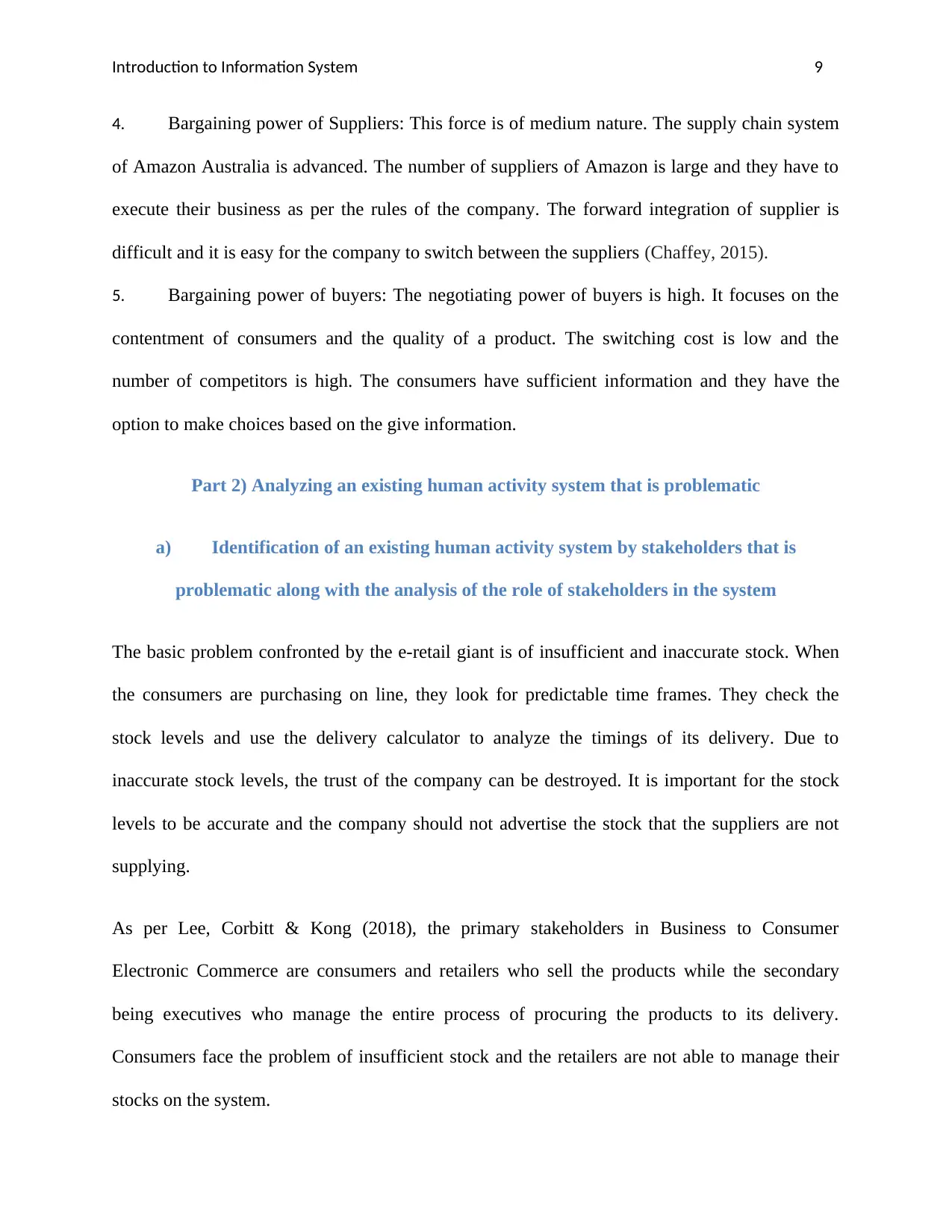
Introduction to Information System 9
4. Bargaining power of Suppliers: This force is of medium nature. The supply chain system
of Amazon Australia is advanced. The number of suppliers of Amazon is large and they have to
execute their business as per the rules of the company. The forward integration of supplier is
difficult and it is easy for the company to switch between the suppliers (Chaffey, 2015).
5. Bargaining power of buyers: The negotiating power of buyers is high. It focuses on the
contentment of consumers and the quality of a product. The switching cost is low and the
number of competitors is high. The consumers have sufficient information and they have the
option to make choices based on the give information.
Part 2) Analyzing an existing human activity system that is problematic
a) Identification of an existing human activity system by stakeholders that is
problematic along with the analysis of the role of stakeholders in the system
The basic problem confronted by the e-retail giant is of insufficient and inaccurate stock. When
the consumers are purchasing on line, they look for predictable time frames. They check the
stock levels and use the delivery calculator to analyze the timings of its delivery. Due to
inaccurate stock levels, the trust of the company can be destroyed. It is important for the stock
levels to be accurate and the company should not advertise the stock that the suppliers are not
supplying.
As per Lee, Corbitt & Kong (2018), the primary stakeholders in Business to Consumer
Electronic Commerce are consumers and retailers who sell the products while the secondary
being executives who manage the entire process of procuring the products to its delivery.
Consumers face the problem of insufficient stock and the retailers are not able to manage their
stocks on the system.
4. Bargaining power of Suppliers: This force is of medium nature. The supply chain system
of Amazon Australia is advanced. The number of suppliers of Amazon is large and they have to
execute their business as per the rules of the company. The forward integration of supplier is
difficult and it is easy for the company to switch between the suppliers (Chaffey, 2015).
5. Bargaining power of buyers: The negotiating power of buyers is high. It focuses on the
contentment of consumers and the quality of a product. The switching cost is low and the
number of competitors is high. The consumers have sufficient information and they have the
option to make choices based on the give information.
Part 2) Analyzing an existing human activity system that is problematic
a) Identification of an existing human activity system by stakeholders that is
problematic along with the analysis of the role of stakeholders in the system
The basic problem confronted by the e-retail giant is of insufficient and inaccurate stock. When
the consumers are purchasing on line, they look for predictable time frames. They check the
stock levels and use the delivery calculator to analyze the timings of its delivery. Due to
inaccurate stock levels, the trust of the company can be destroyed. It is important for the stock
levels to be accurate and the company should not advertise the stock that the suppliers are not
supplying.
As per Lee, Corbitt & Kong (2018), the primary stakeholders in Business to Consumer
Electronic Commerce are consumers and retailers who sell the products while the secondary
being executives who manage the entire process of procuring the products to its delivery.
Consumers face the problem of insufficient stock and the retailers are not able to manage their
stocks on the system.
Paraphrase This Document
Need a fresh take? Get an instant paraphrase of this document with our AI Paraphraser
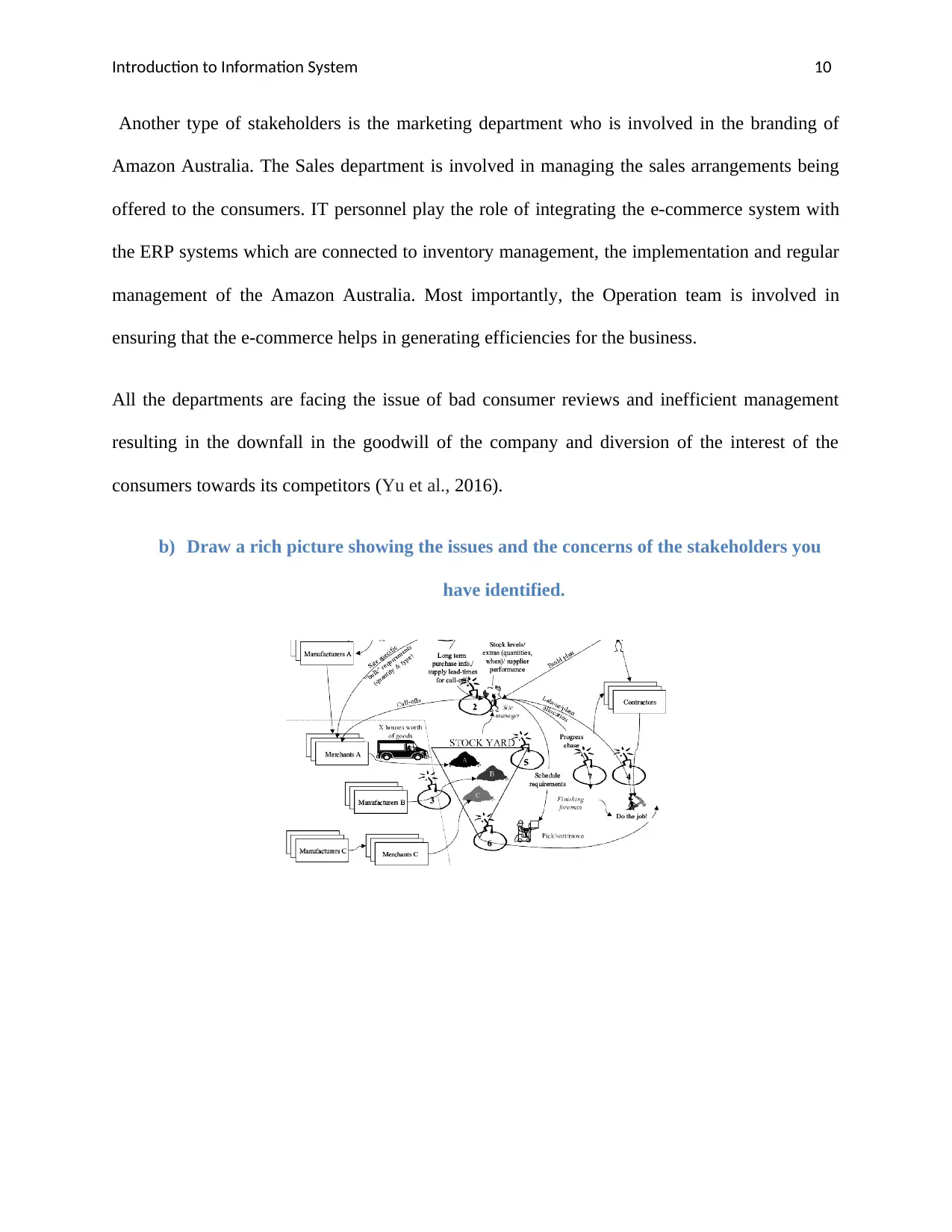
Introduction to Information System 10
Another type of stakeholders is the marketing department who is involved in the branding of
Amazon Australia. The Sales department is involved in managing the sales arrangements being
offered to the consumers. IT personnel play the role of integrating the e-commerce system with
the ERP systems which are connected to inventory management, the implementation and regular
management of the Amazon Australia. Most importantly, the Operation team is involved in
ensuring that the e-commerce helps in generating efficiencies for the business.
All the departments are facing the issue of bad consumer reviews and inefficient management
resulting in the downfall in the goodwill of the company and diversion of the interest of the
consumers towards its competitors (Yu et al., 2016).
b) Draw a rich picture showing the issues and the concerns of the stakeholders you
have identified.
Another type of stakeholders is the marketing department who is involved in the branding of
Amazon Australia. The Sales department is involved in managing the sales arrangements being
offered to the consumers. IT personnel play the role of integrating the e-commerce system with
the ERP systems which are connected to inventory management, the implementation and regular
management of the Amazon Australia. Most importantly, the Operation team is involved in
ensuring that the e-commerce helps in generating efficiencies for the business.
All the departments are facing the issue of bad consumer reviews and inefficient management
resulting in the downfall in the goodwill of the company and diversion of the interest of the
consumers towards its competitors (Yu et al., 2016).
b) Draw a rich picture showing the issues and the concerns of the stakeholders you
have identified.
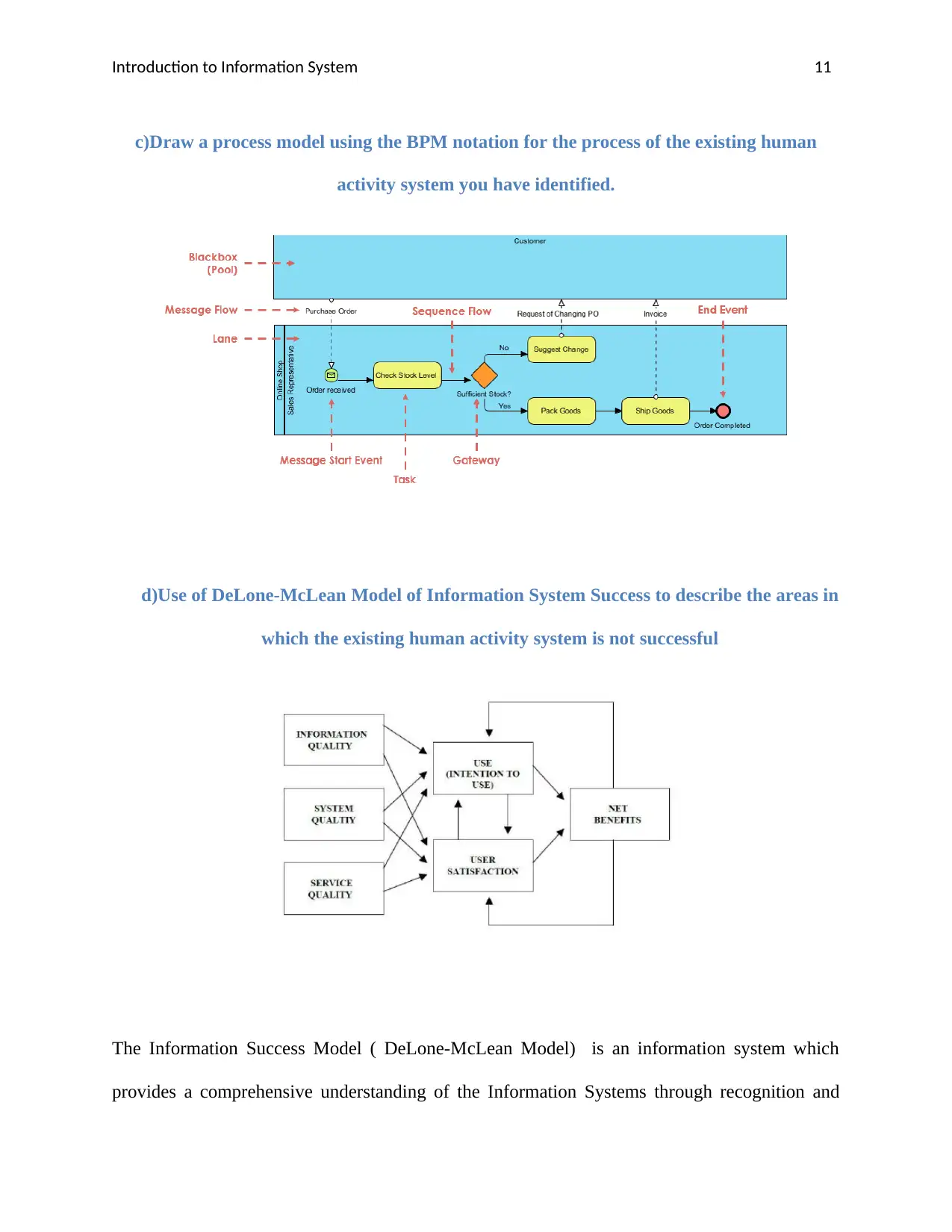
Introduction to Information System 11
c)Draw a process model using the BPM notation for the process of the existing human
activity system you have identified.
d)Use of DeLone-McLean Model of Information System Success to describe the areas in
which the existing human activity system is not successful
The Information Success Model ( DeLone-McLean Model) is an information system which
provides a comprehensive understanding of the Information Systems through recognition and
c)Draw a process model using the BPM notation for the process of the existing human
activity system you have identified.
d)Use of DeLone-McLean Model of Information System Success to describe the areas in
which the existing human activity system is not successful
The Information Success Model ( DeLone-McLean Model) is an information system which
provides a comprehensive understanding of the Information Systems through recognition and
⊘ This is a preview!⊘
Do you want full access?
Subscribe today to unlock all pages.

Trusted by 1+ million students worldwide
1 out of 22
Related Documents
Your All-in-One AI-Powered Toolkit for Academic Success.
+13062052269
info@desklib.com
Available 24*7 on WhatsApp / Email
![[object Object]](/_next/static/media/star-bottom.7253800d.svg)
Unlock your academic potential
Copyright © 2020–2025 A2Z Services. All Rights Reserved. Developed and managed by ZUCOL.





